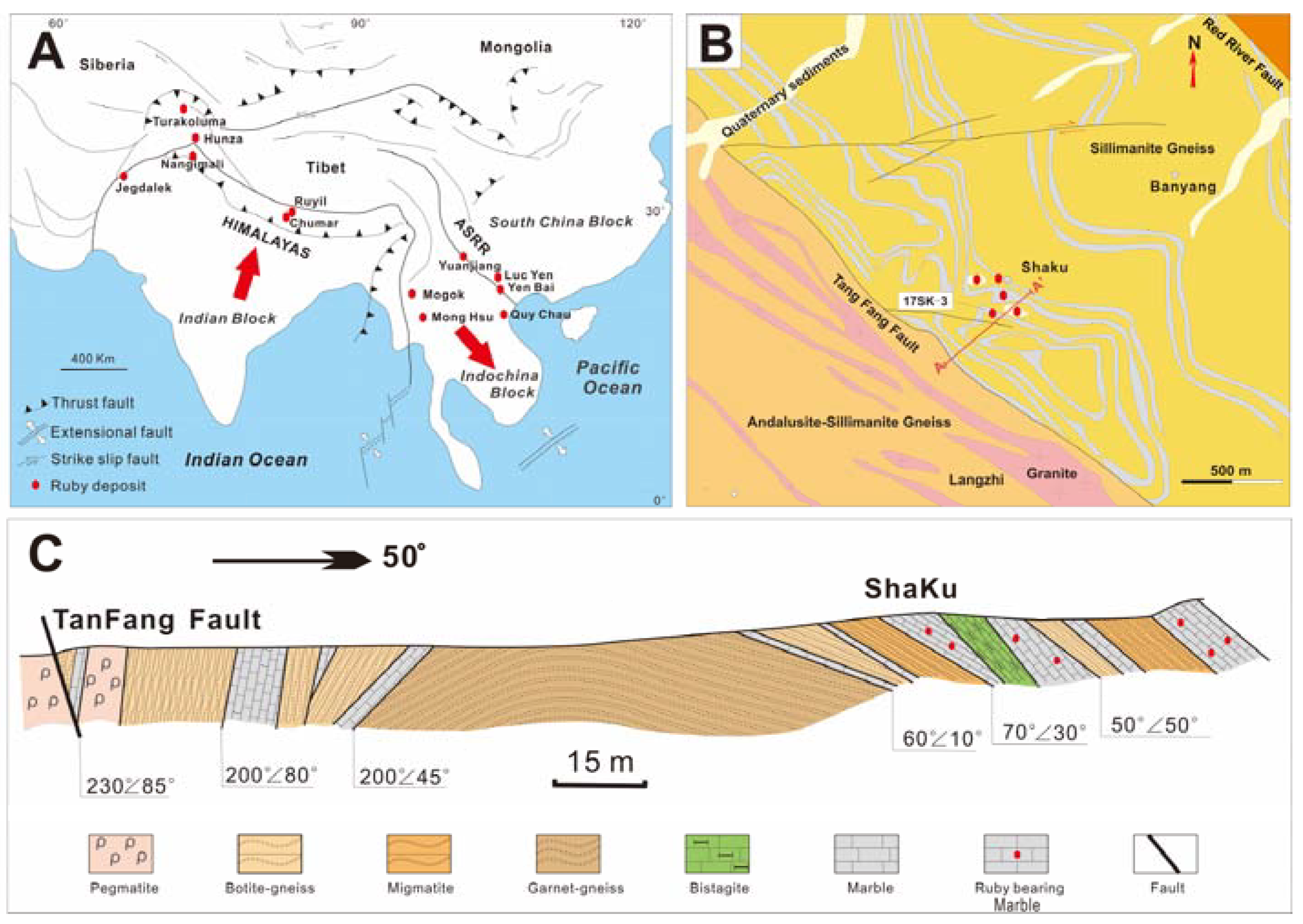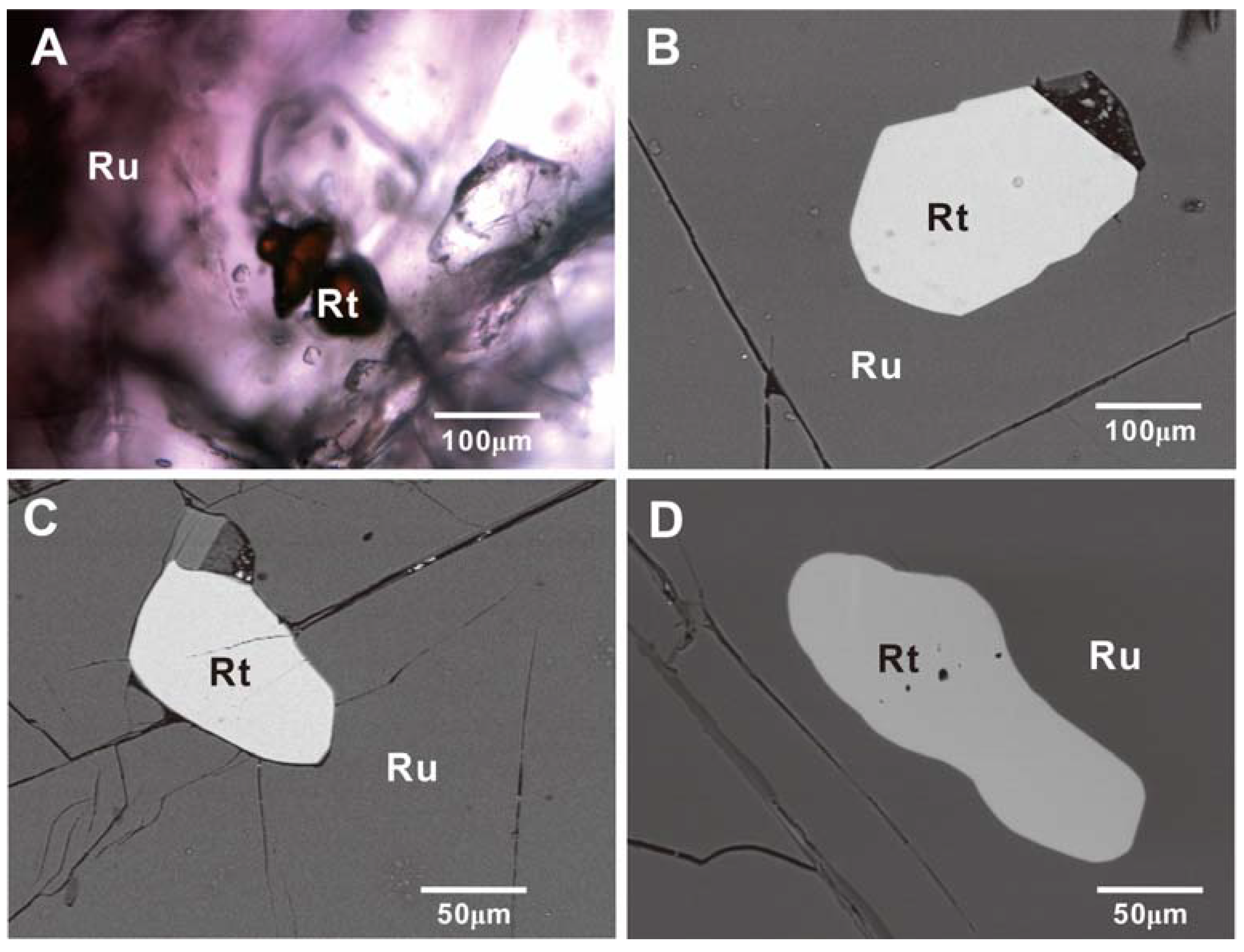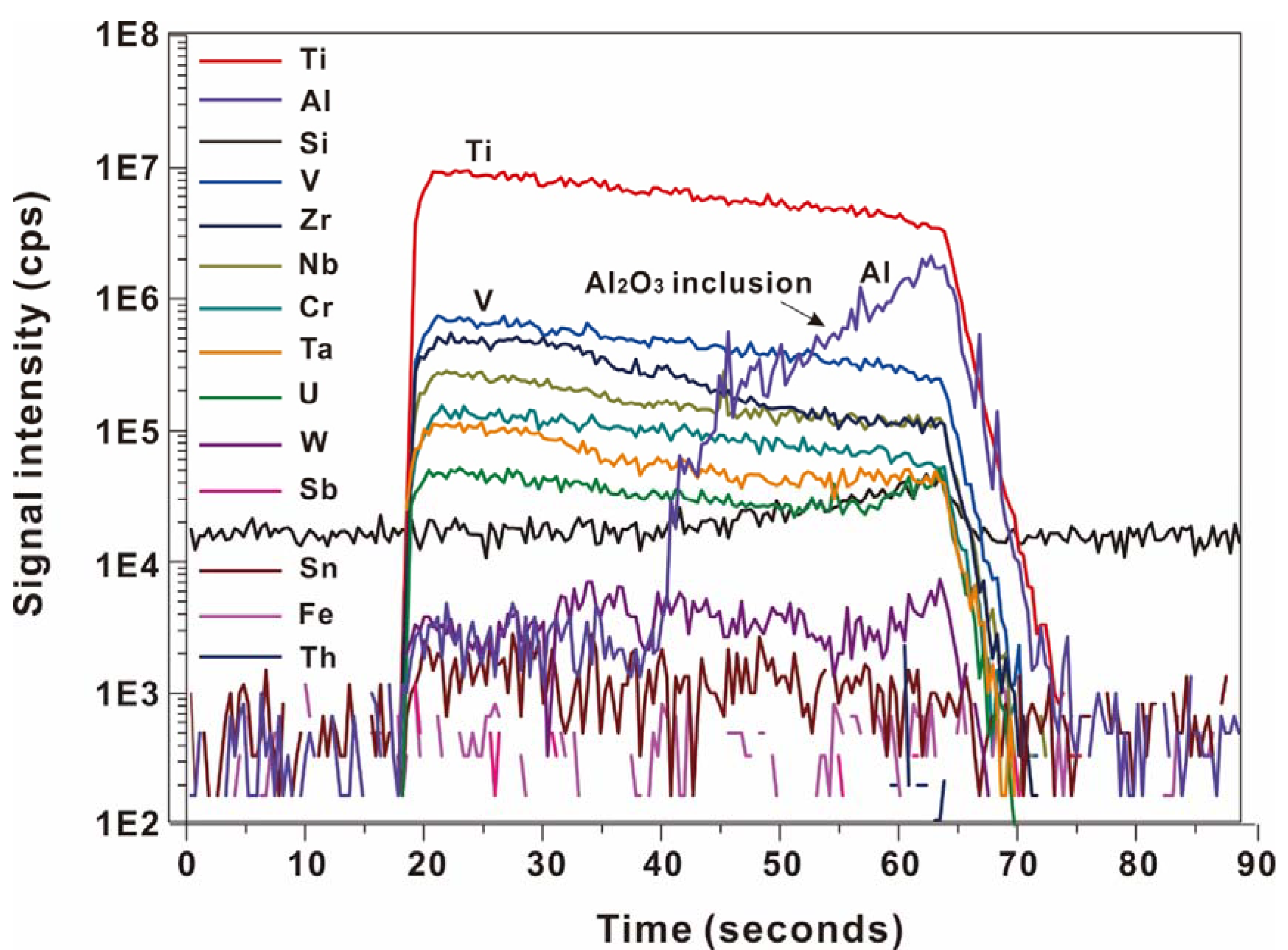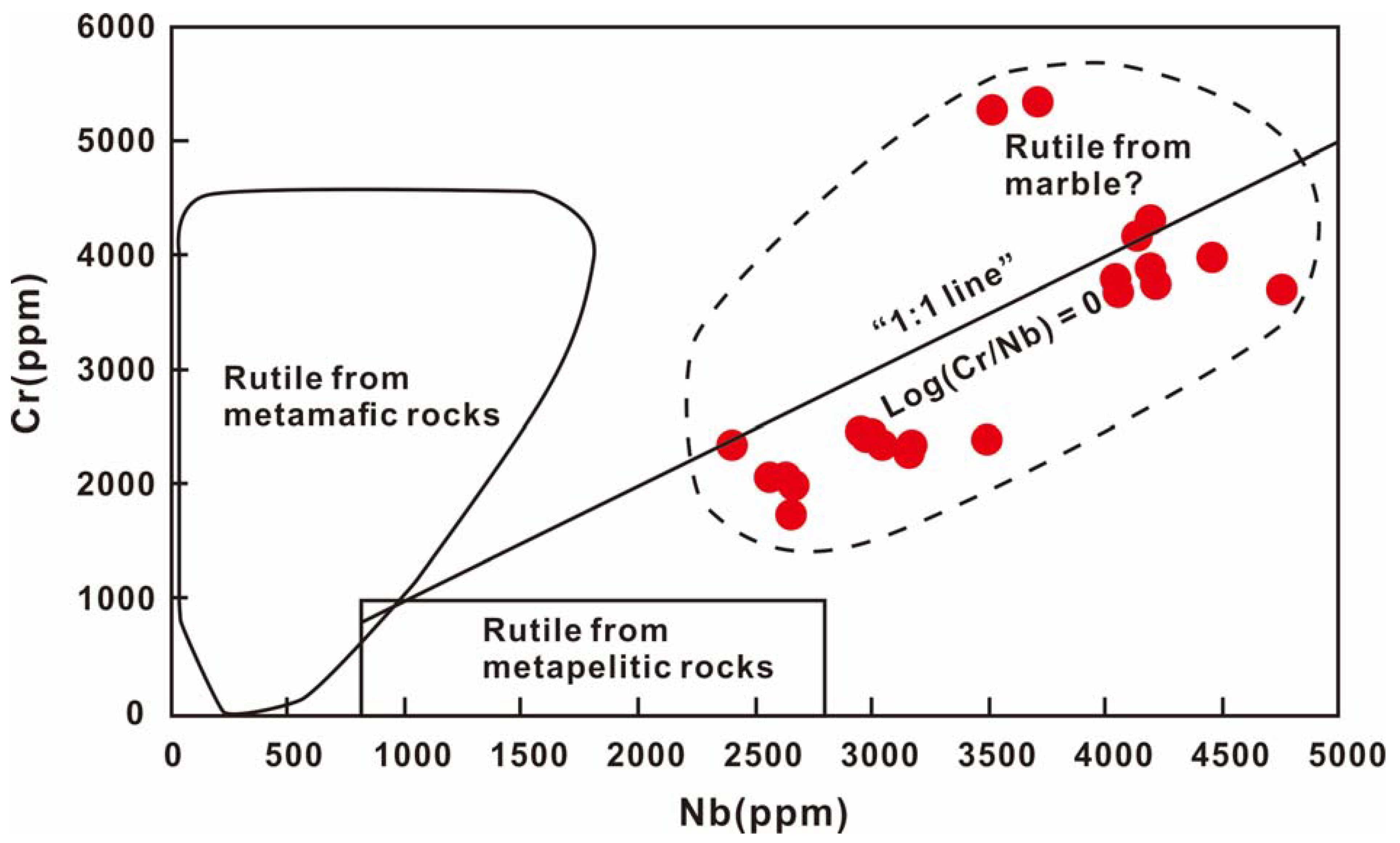LA-ICP-MS U–Pb Dating of Cenozoic Rutile Inclusions in the Yuanjiang Marble-Hosted Ruby Deposit, Ailao Shan Complex, Southwest China
Abstract
:1. Introduction
2. Geological Setting
3. Materials and Methods
4. Results
4.1. Raman Analyses of Rutile Inclusions
4.2. Trace Elemental and U–Pb Dating Results of Rutile Inclusions
5. Discussion
5.1. The Relationship between Rutile and Ruby
5.2. Interpretation of Rutile Inclusion U–Pb Dating Results
5.3. The Spatial-Temporal Relationship of the Ruby Mineralization and Tectonic Evolution
6. Conclusions
Author Contributions
Funding
Institutional Review Board Statement
Informed Consent Statement
Data Availability Statement
Acknowledgments
Conflicts of Interest
References
- Garnier, V.; Giuliani, G.; Ohnenstetter, D.; Fallick, A.E.; Dubessy, J.; Banks, D.; Vinh, H.Q.; Lhomme, T.; Maluski, H.; Pêcher, A.; et al. Marble-hosted ruby deposits from Central and Southeast Asia: Towards a new genetic model. Ore Geol. Rev. 2008, 34, 169–191. [Google Scholar] [CrossRef]
- Stern, B.; Tsujimori, T.; Harlow, G.; Groat, L.A. Plate tectonic gemstones. Geology 2013, 41, 723–726. [Google Scholar] [CrossRef]
- Qian, T.H.; Yao, S.Z.; Wang, Y.Z. The geological features and meaning of ruby deposit in Ailaoshan, Yunnan Province. Miner. Depos. 1996, 15, 29–30. (In Chinese) [Google Scholar]
- Zhang, J.F.; Zhou, C.H.; Hu, C.S. Mineralization characteristics of gems in Ailaoshan structural belt, Yunnan Province. J. Gems. Gem. 2003, 5, 27–30, (In Chinese with English abstract). [Google Scholar]
- Yang, T.J.; Sun, X.M.; Shi, G.Y.; Li, D.S.; Zhou, H.Y. The genetic linkage between the Yuanjiang marble-hosted ruby deposit and Cenozoic tectonic evolution of the Ailao Shan-Red River shear zone (Southwest China). J. Asian Earth Sci. 2019, 177, 38–47. [Google Scholar] [CrossRef]
- Harrison, T.M.; Celerier, J.; Aikman, A.B.; Hermann, J.; Heizler, M.T. Diffusion of 40Ar in muscovite. Geochim. Cosmochim. Acta 2009, 73, 1039–1051. [Google Scholar] [CrossRef]
- Garnier, V.; Giuliani, G.; Maluski, H.; Ohnenstetter, D.; Trong, T.P.; Quang, V.H.; Van, L.P.; Van, T.V.; Schwarz, D. Ar–Ar ages in phlogopites from marble–hosted ruby deposits in northern Vietnam: Evidence for Cenozoic ruby formation. Chem. Geol. 2002, 188, 33–49. [Google Scholar] [CrossRef]
- Coenraads, R.R.; Sutherland, F.L.; Kinny, P.D. The origin of sapphires: U-Pb dating of zircon inclusions sheds new light. Mineral. Mag. 1990, 54, 113–122. [Google Scholar] [CrossRef]
- Coenraads, R.R.; Vichit, P.; Sutherland, F.L. An unusual sapphire-zircon-magnetite xenolith from the Chanthaburi Gem Province. Minear. Mag. 1995, 59, 465–479. [Google Scholar] [CrossRef]
- Sutherland, F.L.; Bosshart, G.; Fanning, C.M.; Hoskin, P.W.O.; Coenraads, R.R. Sapphire crystallization, age and origin, Ban Huai Sai, Laos: Age based on zircon inclusions. J. Asian Earth Sci. 2002, 20, 841–849. [Google Scholar] [CrossRef]
- Sutherland, F.L.; Duroc-Danner, J.M.; Meffre, S. Age and origin of gem corundum and zircon megacrysts from the Mercaderes–Rio Mayo area, South-west Colombia, South America. Ore Geol. Rev. 2008, 34, 155–168. [Google Scholar] [CrossRef]
- Graham, I.; Sutherland, L.; Zaw, K.; Nechaev, V.; Khanchuk, A. Advances in our understanding of the gem corundum deposits of the West Pacific continental margins intraplate basaltic fields. Ore Geol. Rev. 2008, 34, 200–215. [Google Scholar] [CrossRef]
- Sorokina, E.S.; Rösel, D.; Häger, T.; Mertz-Kraus, R.; Saul, J.M. LA-ICP-MS U–Pb dating of rutile inclusions within corundum (ruby and sapphire): New constraints on the formation of corundum deposits along the Mozambique belt. Miner. Depos. 2017, 52, 1–9. [Google Scholar] [CrossRef]
- Meinhold, G. Rutile and its applications in earth sciences. Earth Sci. Rev. 2010, 102, 1–28. [Google Scholar] [CrossRef]
- Cherniak, D.J. Pb diffusion in rutile. Contrib. Miner. Petrol. 2000, 139, 198–207. [Google Scholar] [CrossRef]
- Zack, T.; Stockli, D.F.; Luvizotto, G.L.; Barth, M.G.; Belousova, E.; Wolfe, M.R.; Hinton, R.W. In situ U–Pb rutile dating by LA-ICP-MS: 208Pb correction and prospects for geological applications. Contrib. Miner. Petrol. 2011, 162, 515–530. [Google Scholar] [CrossRef]
- Luvinzotto, G.L.; Zack, T. Nb and Zr behavior in rutile during high-grade metamorphism and retrogression: An example from the Ivrea–Verbano Zone. Chem. Geol. 2009, 261, 303–317. [Google Scholar] [CrossRef]
- Jochum, K.P.; Weis, U.; Schwager, B.; Stoll, B.; Wilson, S.A.; Haug, G.H.; Andreae, M.O.; Enzweiler, J. Reference values following ISO guidelines for frequently requested rock reference materials. Geostand. Geoanal. Res. 2016, 40, 333–350. [Google Scholar] [CrossRef]
- Liu, Y.S.; Gao, S.; Hu, Z.C.; Gao, C.G.; Zong, K.Q.; Wang, D.B. Continental and oceanic crust recycling-induced melt-peridotite interactions in the Trans-North China orogen: U-Pb dating, Hf isotopes and trace elements in zircons from mantle xenoliths. J. Petrol. 2010, 51, 537–571. [Google Scholar] [CrossRef]
- Ludwig, K.R. User’s Manual for Isoplot 3.0: A Geochronological Toolkit for Microsoft Excel; Special Publication; Berkeley Geochronology Center: Berkeley, CA, USA, 2003; pp. 1–70. [Google Scholar]
- He, M.C.; Zhu, X.M.; Hong, B. Raman spectrum feature of ruby from Yuanjiang, Yunnan Province. J. Gems. Gem. 2001, 3, 25–27, (In Chinese with the English abstract). [Google Scholar]
- Pi, Q.H.; Hu, R.Z.; Xiong, B.; Li, Q.L.; Zhong, R.C. In situ SIMS U-Pb dating of hydrothermal rutile: Reliable age for the Zhesang Carlin-type gold deposit in the golden triangle region, SW China. Miner. Depos. 2017, 52, 1179–1190. [Google Scholar] [CrossRef]
- Gubelin, E.J.; Koivula, J.I. Photoatlas of Inclusion in Gemstone; Gemological Institute of America: Zürich, Switzerland, 1986. [Google Scholar]
- Zack, T.; Kronz, A.; Foley, S.F.; Rivers, T. Trace element abundances in rutiles from eclogites and associated garnet mica schists. Chem. Geol. 2002, 184, 97–122. [Google Scholar] [CrossRef]
- Zack, T.; Moraes, R.; Kronz, A. Temperature dependence of Zr in rutile: Empirical calibration of a rutile thermometer. Contrib. Mineral. Petrol. 2004, 148, 471–488. [Google Scholar] [CrossRef]
- Meinhold, G.; Anders, B.; Kostopoulos, D.; Reischmann, T. Rutile chemistry and thermometry as provenance indicator: An example from Chios Island, Greece. Sediment. Geol. 2008, 203, 98–111. [Google Scholar] [CrossRef]
- Agangi, A.; Plavsa, D.; Reddy, S.M.; Oliver, H.; Kylander-Clark, A. Compositional modification and trace element decoupling in rutile: Insight from the Capricorn Orogen, Western Australia. Precambrian Res. 2020, 345, 105772. [Google Scholar] [CrossRef]
- Pêcher, A.; Giuliani, G.; Garnier, V.; Maluski, H.; Kausar, A.B.; Malik, R.H.; Muntaz, H.R. Geology, geochemistry and Ar–Ar geochronology of the Nangimali ruby deposit, Nanga Parbat Himalaya (Azad Kashmir, Pakistan). J. Asian Earth Sci. 2002, 21, 265–282. [Google Scholar] [CrossRef]
- Oliver, H.K.H.; Agangi, A.; Plavsa, D.; Reddy, S.M.; Yao, W.H.; Clark, C.; Occhipinti, S.A.; Kylander-Clark, A.R.C. Neoproterozoic hydrothermal activity in the West Australian Craton related to Rodinia assembly or breakup? Gondwana Res. 2019, 68, 1–12. [Google Scholar]
- Oliver, H.K.H.; Taylor, R.J.M.; Erickson, T.M.; Clark, C.; Reddy, S.M.; Kirkland, C.L.; Jahn, I.; Barham, M. Unravelling complex geologic histories using U–Pb and trace element systematics of titanite. Chem. Geol. 2019, 504, 105–122. [Google Scholar]
- Zhou, T.; Li, Q.L.; Klemd, R.; Shi, Y.H.; Tang, X.; Li, C.F.; Liu, Y. Multi-system geochronology in North Dabie eclogite: Ineffective garnet ‘shielding’ on rutile inclusions under multi-thermal conditions. Lithos 2020, 368–369, 105573. [Google Scholar] [CrossRef]
- Liu, J.L.; Chen, X.Y.; Tang, Y.; Song, Z.J.; Wang, W. The Ailao Shan–Red River shear zone revisited: Timing and tectonic implications. Geol. Soc. Am. Bull. 2019, 132, 5–6. [Google Scholar] [CrossRef]
- Yang, T.J.; Sun, X.M.; Shi, G.Y.; Lu, Y.; Fu, Y. Constraints on the left lateral shearing and crustal melting of the Ailaoshan Massif, Yunnan Province, Southwest China. J. Asian Earth Sci. 2019, 177, 186–197. [Google Scholar] [CrossRef]
- Garnier, V.; Ohnenstetter, D.; Giuliani, G.; Maluski, H.; Deloule, E.; Phan Trong, T.; PhamVan, L.; Hoang Quang, V. Age and significance of ruby-bearing marbles from the Red River shear zone, northern Vietnam. Can. Miner. 2005, 43, 1315–1329. [Google Scholar] [CrossRef]






| Spot No. | Al | Cr | Nb | Zr | V | Ta | Hf | Mg | W | Fe | Cu | Sn | Sb | Mo |
|---|---|---|---|---|---|---|---|---|---|---|---|---|---|---|
| Ru-1 | 41 | 5362 | 3715 | 1026 | 3198 | 592 | 59 | 53 | 25 | 11 | 31 | 12 | 0.6 | 0.2 |
| Ru-2 | 4229 | 5277 | 3516 | 887 | 3138 | 440 | 45 | 60 | 15 | 23 | 28 | 7 | 0.5 | Bdl 1 |
| Ru-3 | 77 | 2353 | 3167 | 2708 | 4772 | 475 | 263 | 45 | 552 | 48 | 6 | 46 | 1.0 | 0.4 |
| Ru-4 | 76 | 3803 | 4041 | 3031 | 5098 | 550 | 154 | 45 | 31 | 18 | 6 | 40 | 0.3 | 0.3 |
| Ru-5 | 73 | 3693 | 4053 | 2930 | 4991 | 505 | 145 | 45 | 27 | 16 | 5 | 37 | 0.1 | 0.1 |
| Ru-6 | 68 | 3762 | 4214 | 2827 | 4856 | 545 | 134 | 42 | 26 | 67 | 6 | 38 | 0.3 | 0.2 |
| Ru-7 | 66 | 3901 | 4186 | 2956 | 5000 | 561 | 142 | 47 | 28 | 19 | 10 | 37 | 0.3 | 0.2 |
| Ru-8 | 59 | 3997 | 4454 | 2980 | 5007 | 658 | 145 | 42 | 35 | 19 | 7 | 37 | 0.3 | 0.4 |
| Ru-9 | 182 | 4186 | 4138 | 2295 | 5722 | 367 | 111 | 51 | 220 | 114 | 9 | 38 | 3.2 | 0.6 |
| Ru-10 | 39 | 4329 | 4196 | 2306 | 5783 | 468 | 106 | 46 | 133 | 15 | 7 | 40 | 0.7 | 0.6 |
| Ru-11 | 38 | 2395 | 3497 | 2153 | 4597 | 476 | 214 | 46 | 144 | 71 | 10 | 114 | 2.0 | 0.2 |
| Ru-12 | 41 | 3704 | 4759 | 2036 | 6693 | 713 | 230 | 47 | 457 | 49 | 7 | 125 | 1.3 | Bdl 1 |
| Ru-13 | 77 | 2428 | 2980 | 2323 | 4382 | 288 | 218 | 42 | 188 | 72 | 6 | 50 | 1.2 | 0.3 |
| Ru-14 | 95 | 2362 | 3049 | 2003 | 4497 | 291 | 160 | 48 | 200 | 48 | 6 | 48 | 1.0 | 1.0 |
| Ru-15 | 240 | 2476 | 2952 | 2405 | 4378 | 248 | 256 | 54 | 176 | 61 | 8 | 47 | 1.7 | 0.4 |
| Ru-16 | 61 | 2446 | 3001 | 2400 | 4279 | 257 | 255 | 46 | 183 | 58 | 8 | 42 | 1.1 | 0.6 |
| Ru-17 | 205 | 2284 | 3161 | 1441 | 4560 | 331 | 74 | 41 | 252 | 87 | 7 | 61 | 1.7 | 2.2 |
| Ru-18 | 3339 | 2074 | 2628 | 1990 | 4048 | 252 | 177 | 64 | 167 | 40 | 6 | 59 | 0.9 | 0.1 |
| Ru-19 | 56 | 1995 | 2664 | 2131 | 4394 | 289 | 192 | 45 | 90 | 543 | 6 | 63 | 0.6 | Bdl 1 |
| Ru-20 | 87 | 1743 | 2657 | 2012 | 4575 | 323 | 174 | 60 | 97 | 68 | 6 | 60 | 1.1 | 0.2 |
| Ru-21 | 108 | 2068 | 2558 | 2351 | 4555 | 336 | 203 | 48 | 145 | 63 | 68 | 55 | 0.9 | 0.4 |
| Ru-22 | 84 | 2365 | 2407 | 2296 | 4476 | 303 | 231 | 46 | 137 | 88 | 4 | 48 | 0.7 | Bdl 1 |
| Spot No. | Th | U | Measured Isotope Ratios | |||||
|---|---|---|---|---|---|---|---|---|
| ppm | ppm | 207Pb/206Pb | 1sigma | 207Pb/235U | 1sigma | 206Pb/238U | 1sigma | |
| Ru-1 | 0.1 | 21 | 0.3483 | 0.0817 | 0.3169 | 0.0506 | 0.0059 | 0.0005 |
| Ru-2 | 0.0 | 25 | 0.5539 | 0.0856 | 0.6413 | 0.0672 | 0.0094 | 0.0007 |
| Ru-3 | 0.0 | 43 | 0.1809 | 0.0478 | 0.1012 | 0.0283 | 0.0043 | 0.0004 |
| Ru-4 | 0.0 | 102 | 0.1423 | 0.0372 | 0.0608 | 0.0297 | 0.0031 | 0.0002 |
| Ru-5 | 0.0 | 101 | 0.1293 | 0.0274 | 0.0597 | 0.0173 | 0.0035 | 0.0002 |
| Ru-6 | 0.0 | 97 | 0.0989 | 0.0184 | 0.0441 | 0.0070 | 0.0035 | 0.0002 |
| Ru-7 | 0.0 | 99 | 0.1469 | 0.0331 | 0.0510 | 0.0083 | 0.0031 | 0.0002 |
| Ru-8 | 0.0 | 103 | 0.2616 | 0.1179 | 0.0769 | 0.0151 | 0.0041 | 0.0002 |
| Ru-9 | 2.0 | 120 | 0.2476 | 0.0687 | 0.0895 | 0.0150 | 0.0041 | 0.0003 |
| Ru-10 | 0.2 | 122 | 0.1796 | 0.0709 | 0.0408 | 0.0098 | 0.0033 | 0.0002 |
| Ru-11 | 0.1 | 9 | 0.1346 | 0.0773 | 0.2280 | 0.0620 | 0.0058 | 0.0008 |
| Ru-12 | 0.6 | 19 | 0.0532 | 0.0241 | 0.1032 | 0.0524 | 0.0040 | 0.0005 |
| Ru-13 | 0.2 | 38 | 0.3455 | 0.0798 | 0.1345 | 0.0222 | 0.0042 | 0.0004 |
| Ru-14 | 0.1 | 61 | 0.2629 | 0.0494 | 0.1300 | 0.0194 | 0.0043 | 0.0003 |
| Ru-15 | 0.1 | 30 | 0.2356 | 0.0753 | 0.1856 | 0.0380 | 0.0042 | 0.0004 |
| Ru-16 | 0.0 | 29 | 0.2366 | 0.0790 | 0.2084 | 0.0633 | 0.0045 | 0.0006 |
| Ru-17 | 2.5 | 96 | 0.3802 | 0.0704 | 0.3002 | 0.0455 | 0.0064 | 0.0006 |
| Ru-18 | 1.8 | 154 | 0.1832 | 0.0489 | 0.0597 | 0.0119 | 0.0034 | 0.0002 |
| Ru-19 | 0.0 | 19 | 0.0866 | 0.0322 | 0.1188 | 0.0309 | 0.0042 | 0.0007 |
| Ru-20 | 0.0 | 20 | 0.2753 | 0.0675 | 0.3103 | 0.0467 | 0.0061 | 0.0006 |
| Ru-21 | 0.6 | 22 | 0.1997 | 0.0616 | 0.2072 | 0.0541 | 0.0060 | 0.0004 |
| Ru-22 | 0.4 | 21 | 0.5463 | 0.0866 | 0.5879 | 0.0786 | 0.0083 | 0.0008 |
Publisher’s Note: MDPI stays neutral with regard to jurisdictional claims in published maps and institutional affiliations. |
© 2021 by the authors. Licensee MDPI, Basel, Switzerland. This article is an open access article distributed under the terms and conditions of the Creative Commons Attribution (CC BY) license (https://creativecommons.org/licenses/by/4.0/).
Share and Cite
Yang, T.; Sun, X.; Shi, G.; Liu, Y. LA-ICP-MS U–Pb Dating of Cenozoic Rutile Inclusions in the Yuanjiang Marble-Hosted Ruby Deposit, Ailao Shan Complex, Southwest China. Minerals 2021, 11, 433. https://doi.org/10.3390/min11040433
Yang T, Sun X, Shi G, Liu Y. LA-ICP-MS U–Pb Dating of Cenozoic Rutile Inclusions in the Yuanjiang Marble-Hosted Ruby Deposit, Ailao Shan Complex, Southwest China. Minerals. 2021; 11(4):433. https://doi.org/10.3390/min11040433
Chicago/Turabian StyleYang, Tianjian, Xiaoming Sun, Guiyong Shi, and Ying Liu. 2021. "LA-ICP-MS U–Pb Dating of Cenozoic Rutile Inclusions in the Yuanjiang Marble-Hosted Ruby Deposit, Ailao Shan Complex, Southwest China" Minerals 11, no. 4: 433. https://doi.org/10.3390/min11040433
APA StyleYang, T., Sun, X., Shi, G., & Liu, Y. (2021). LA-ICP-MS U–Pb Dating of Cenozoic Rutile Inclusions in the Yuanjiang Marble-Hosted Ruby Deposit, Ailao Shan Complex, Southwest China. Minerals, 11(4), 433. https://doi.org/10.3390/min11040433






